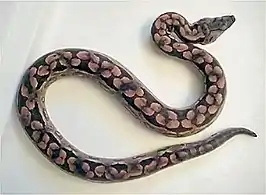Acrantophis dumerili
Acrantophis dumerili, commonly known as Dumeril's boa,[1] is a non-venomous boa species found on Madagascar. No subspecies are currently recognized.[3][4]
| Acrantophis dumerili | |
|---|---|
_male_Reniala.jpg.webp) | |
| male in Reserve Reniala, Madagascar | |
| Scientific classification | |
| Kingdom: | Animalia |
| Phylum: | Chordata |
| Class: | Reptilia |
| Order: | Squamata |
| Suborder: | Serpentes |
| Family: | Boidae |
| Genus: | Acrantophis |
| Species: | A. dumerili |
| Binomial name | |
| Acrantophis dumerili | |
| Synonyms[2] | |
Etymology
The specific name, dumerili, is in honor of French herpetologist André Marie Constant Duméril.[5]
Description
Adults of A. dumerili usually grow to 6.5 feet (2 m) in total length (including tail)[6] with the maximum reported to be 8 foot, 6 inches (259 cm). Males usually have longer skinnier tails, while females tend to be larger overall.
The color pattern consists of a gray-brown ground color with darker patches, forming an effective camouflage against the leaf litter of the forest floor of their native habitat.

 in London Zoo
in London Zoo_male_head_Isalo.jpg.webp)
Distribution and habitat
A. dumerili is found on Madagascar. The type locality given in the original description is "Amérique mérid. ?", which is later given as "?" by Jan (1863).[2]
Along the western coast and southwestern regions of Madagascar, it is found in a semi-arid habitat that gets fairly low amounts of precipitation.
Conservation status
The species A. dumerili is classified as Least Concern (LC) on the IUCN Red List for the following criteria: A1cd (v2.3, 1994).[1] This means that a population reduction of at least 20% has been observed, estimated, inferred or suspected over the last 10 years or three generations, whichever is the longer, based on a decline in area of occupancy, extent of occurrence and/or quality of habitat, and based on actual or potential levels of exploitation.[7] The species was last assessed in 2011.[1]
A. dumerili is also listed as CITES Appendix I, which means that it is threatened with extinction and CITES prohibits international trade except when the purpose of the import is not commercial, for example for scientific research.[8]
It is threatened by deforestation and human persecution. In some areas it is feared and often killed on sight. Although some native lore would relate stories of the souls of the tribes ancestors being in the snake skins, because patterns of faces on the sides of the snakes are interpreted, making them religiously sacred and therefore not dangerous to some cultures.
Feeding
The diet of A. dumerili consists of small animals, such as birds, lizards, and small mammals, including juvenile lemurs. It is also known to prey on other snakes.
Reproduction
In A. dumerili sexual maturity is reached within 3 to 5 years of age. Males have anal spurs, which are used in courtship. The mating season is March through May, and the young are born some 6 to 8 months later. Ovoviviparous, females give birth to a litters of 6-28. Neonates are 12-18 inches (30–46 cm) long.
Captivity
Once exported from Madagascar in great numbers, trade in A. dumerili has since been heavily restricted. The species is, however, quite prolific in captivity, and captive bred individuals are relatively inexpensive and easy to find in the exotic pet trade. Though its size makes it more suited to someone experienced with large constrictors, it has a typically docile nature, and readily feeds on rats. The main concern is that it is prone to stress, which can sometimes cause it to stop eating or can contribute to other health issues.
References
- Raxworthy CJ; Ramanamanjato J-B; Randriamahazo H (2011). "Acrantophis dumerili ". IUCN Red List of Threatened Species. 2011: e.T282A13054798. doi:10.2305/IUCN.UK.2011-2.RLTS.T282A13054798.en.
- McDiarmid RW, Campbell JA, Touré T (1999). Snake Species of the World: A Taxonomic and Geographic Reference, Volume 1. Washington, District of Columbia: Herpetologists' League. 511 pp. ISBN 1-893777-00-6 (series). ISBN 1-893777-01-4 (volume).
- "Acrantophis dumerili". Integrated Taxonomic Information System. Retrieved 17 February 2014.
- Glaw, Frank; Vences, Miguel (2007). A Field Guide to the Amphibians and Reptiles of Madagascar (3rd ed.). Cologne, Germany: Vences & Glaw Verlags. ISBN 978-3929449037.
- Beolens, Bo; Watkins, Michael; Grayson, Michael (2011). The Eponym Dictionary of Reptiles. Baltimore: Johns Hopkins University Press. xiii + 296 pp. ISBN 978-1-4214-0135-5. (Acrantophis dumerili, p. 77).
- Burnie D, Wilson DE (2001). Animal. London: Dorling Kindersley. 624 pp. ISBN 0-7894-7764-5.
- 1994 Categories & Criteria (version 2.3) at the IUCN Red List. Accessed 10 July 2008.
- Acrantophis dumerili at CITES and United Nations Environment Programme / World Conservation Monitoring Centre. Accessed 10 July 2008.
Further reading
- Boulenger GA (1893). Catalogue of the Snakes in the British Museum (Natural History). Volume I., Containing the Families ... Boidæ ... London: Trustees of the British Museum (Natural History). (Taylor and Francis, printers). xiii + 448 pp. + Plates I-XXVIII. (Boa dumerilii, p. 120).
- Jan G, [ Sordelli F ] "1861" [1860]. Iconographie générale des Ophidiens, Première livraison. Paris: Baillière. Index + Plates I-VI. (Acrantophis dumerili, new species, Plate II). (in French).
- Kluge AG (1991). "Boine Snake Phylogeny and Research Cycles". Misc. Pub. Museum of Zoology, Univ. of Michigan (178): 1-58. PDF at University of Michigan Library. Accessed 11 July 2008.
- Vences M, Glaw F, Kosuch J, Böhme W, Veith M (2001). "Phylogeny of South American and Malagasy Boine Snakes: Molecular Evidence for the Validity of Sanzinia and Acrantophis and Biogeographic Implications". Copeia 2001 (4): 1151-1154. PDF at Miguel Vences. Accessed 29 August 2008.
- Vences M, Glaw F (2003). "Phylogeography, systematics and conservation status of boid snakes from Madagascar (Sanzinia and Acrantophis)". Salamandra, Reinbach 39 (3/4): 181-206. PDF at Miguel Vences. Accessed 29 August 2008.
- Healey, Mariah. "Dumeril’s Boa Care Guide". ReptiFiles. Accessed 6 June 2020.
External links
| Wikimedia Commons has media related to Boa dumerili. |
- Acrantophis dumerili at the Reptarium.cz Reptile Database. Accessed 10 July 2008.
